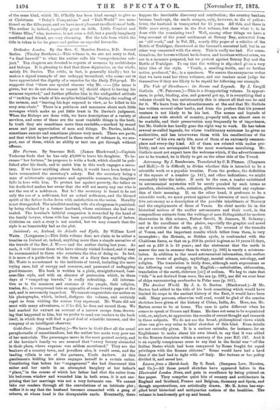Astronomy. By J. Rambosson. Translated by C. B. Pitman. (Chapman
and Hall.)—It is difficult to divine whether this is intended to be a scientific work or a popular treatise. From the preface, the definition of the square of a number (p. 141), and other indications, we might reasonably infer the latter. If such be the case, a reader uninitiated in astronomical mysteries will be sorely puzzled by such terms as parallax, aberration, node, nutation, gibbousness, without any explana- tion of their meaning. If, on the other hand, it professes to be a scientific work, we must protest against the intrusion of such imagina- tive astronomy as a description of the possible inhabitants of Mercury and the employments of those of Venus. Its chief merits lie in the historical notices of the earlier astronomers and their work, in, the compendious extracts from the writings of men distinguished for modern discoveries in this science, Father Seccbi, M. Janssen, M. Delauny; and in the excellence of the plates, especially the graphic and novel one of a section of the earth, on p. 131. Tho account of the transits of Venus, and the important results which follow from them, is very incomplete ; the Metonic, or Golden cycle, is confounded with the Chaldasan Saros, so that on p.219 its period is given as 18 years 11 days, and on p. 349 it is 19 years ; and the statement that the earth is nearer the sun in summer than in winter (p. 106) is surely a mistrans- lation. In addition to the usual astronomical information, this multum in parvo treats of geology, mythology, mental science, astrology, and religion. The translation is fairly done, although such expressions as the following read strangely in English :—nebulosities, obfuscation, translation of the earth, chlorure [sic] of sodium. We beg to state that " tide " is not derived from mare, the sea (p. 228), nor did we ever hear of ships encountering avalanches in Polar seas (p. 181).


































 Previous page
Previous page